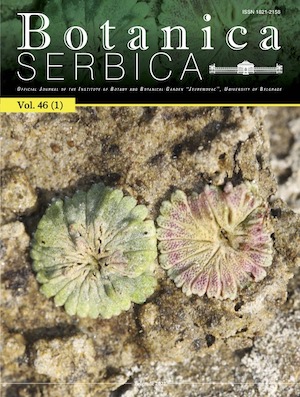
Volume 46 Issue 1 2022 |
Plant histone modifications in response to cold stress
|
KEY WORDS: Cold acclimation, epigenetic regulations, vernalisation, transcriptional reprogramming |
The effect of 24-Epibrassinolide on gene expression related to cell walls under boron deficiency and toxicity in the leaves of Arabidopsis thaliana
|
KEY WORDS: Brassinosteroid, cellulose synthase, expansin, gene expression, pectin methylesterase, xyloglucan endotransglucosylase/hydrolase |
Phytosociology of Stipa-dominated steppe-like vegetation on the ultramafics of the Central Balkans
|
KEY WORDS: dry grasslands, Festuco-Brometea, Halacsyetalia sendtneri, relic, syntaxonomy |
The epiphytic bryophyte succession of Picea orientalis forests on the Kümbet High Plateau (Giresun-Turkey)
|
KEY WORDS: Bryophytes, epiphytic, succession, TWINSPAN, DECORANA, Turkey |
Terpene relationships among some soft and hard pine species
|
KEY WORDS: pear, extracts, antioxidant activity, antidiabetic activity, cytotoxic activity |
Micropropagation and ex situ conservation of three rare and endemic ornamental Dianthus taxa (Caryophyllaceae)
|
KEY WORDS: auxins, cytokinins, in vitro, endangered, wild carnations |
Surface sediment diatom assemblages from four alpine lakes in the Zelengora Mountains (Bosnia and Herzegovina): A Pilot Study
|
KEY WORDS: biomonitoring, Bacillariophyceae, lake water hydrochemistry, Balkan Peninsula |
Phylogenetic relationships of Origanum taxa (Lamiaceae) from Greece: Initial
insights from molecular and morphological data
|
KEY WORDS: Nepetoideae, molecular phylogeny,morphological phylogeny, botany, Aegean Flora |
Prokaryotic expression and solubilisation of Arabidopsis ROOT UVB SENSITIVE 1 from inclusion bodies in Escherichia coli
|
KEY WORDS: Seamless cloning, inclusion body, renaturation, protein purification, Western blot |
Chemical composition and chemosystematic evaluation of the fruit and root headspace fractions of selected Heracleum taxa from Southeastern Europe
|
|
Aspicilia nigromaculata sp. nov. (Megasporaceae, Pertusariales, Ascomycota) from Azad Jammu and Kashmir, Pakistan, evidence from morphology and DNA sequencing data
|
KEY WORDS: ITS nrDNA, nrLSU, phylogeny, saxicolous lichens |
Boron toxicity impacts on photosystem II photochemical efficiency of sage (Salvia officinalis)
|
KEY WORDS: chlorophyll fluorescence, fluorescence transient, JIP test, nutrient toxicity, photosynthesis, photosynthetic pigments. |
Hieracium micevskii (Asteraceae), a new species from North Macedonia
|
KEY WORDS: Hieracium olympicum, Hieracium sect. Olympica, Hieracium sect. Pannosa, Compositae, holotype, hybrid origin |
New records and noteworthy data of plants, algae and fungi in SE Europe and adjacent regions, 7
|
KEY WORDS: new report, Cardamine serbica, Cardamine waldsteinii, Chara intermedia, Gladiolus palustris, Fossombronia wondraczekii, Hamatocaulis vernicosus, Hieracium kotschyanum, Hookeria lucens, Neotinea tridentata, Orchis militaris, Pilosella petraea, Pseudomoerckia blyttii, SE Europe |
New records and noteworthy data of plants, algae and fungi in SE Europe and adjacent regions, 8
|
KEY WORDS: new report, Aconitum anthora, Arundo donax, Cephalanthera rubra, Cephalaria pastricensis, Cylindrotheca gracilis, Dicranum viride, Epipactis palustris, Laccaria macrocystidiata, Riccia canaliculata, Riccia cavernosa, Riccia frostii, Sternbergia colchiciflora, SE Europe |
Stem anatomical survey of the genera Matricaria and Tripleurospermum (Asteraceae) from Turkey with its taxonomical and ecological implications
|
KEY WORDS: Compositae, chamomile, mayweed, numerical taxonomy |
Validation and typification of Verbascum hybrids (Scrophulariaceae) published by Svante Murbeck and deposited at the Belgrade University Herbarium (BEOU)
|
KEY WORDS: BEOU, Murbeck, nothospecies novae, Verbascum |
List of reviewers for Botanica Serbica in 2021 — Acknowledgements
|


